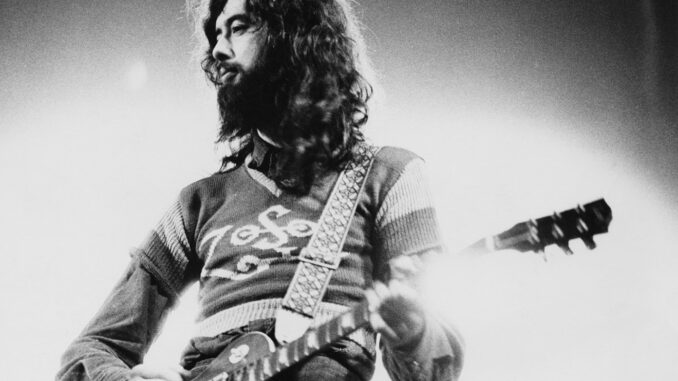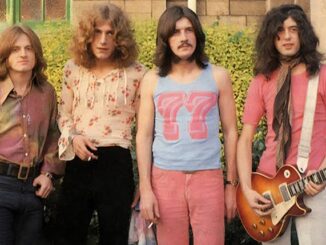
The Story of Jimmy Page’s Led Zeppelin Les Pauls: Four Guitars That Shaped a Rock Revolution
Few guitarists have left as lasting an impression on rock music as Jimmy Page. As the mastermind behind Led Zeppelin’s monumental sound, Page not only crafted some of the most iconic riffs in rock history but also helped immortalize the guitar itself as a symbol of raw, creative power. At the heart of his sonic legacy are four legendary Gibson Les Paul guitars — instruments that not only shaped Led Zeppelin’s sound but also became part of rock and roll mythology. This is the story of Jimmy Page’s Les Pauls, and how they helped build the sonic walls of Led Zeppelin.
The Icon: The 1959 Gibson Les Paul Standard “Number One”
Jimmy Page’s most famous Les Paul, and arguably the most iconic of all time, is his 1959 Gibson Les Paul Standard, affectionately known as “Number One.” Page acquired the guitar in 1969 from Joe Walsh of the James Gang, who reportedly sold it to Page for around $500 — a price that now sounds laughable given the instrument’s immense historical value.
“Number One” became Page’s main workhorse, instantly replacing his Fender Telecaster which he had used on Led Zeppelin’s debut album. With its thick mahogany body, flame maple top, and two powerful PAF humbuckers, this Les Paul gave Page the deep, growling tone that defined Zeppelin’s heavier sound on albums like Led Zeppelin II and Physical Graffiti.
But it wasn’t just about the tone — Page modified the guitar to suit his evolving style. He shaved the neck down to a thinner profile and installed push-pull pots for coil splitting, adding tonal versatility. On stage, “Number One” was rarely out of his hands, powering classics like “Whole Lotta Love,” “Black Dog,” and the epic “Stairway to Heaven” solo. It was the ultimate marriage of form and function — elegant, brutal, and endlessly expressive.
The Backup: The 1959 Gibson Les Paul Standard “Number Two”
Not long after securing “Number One,” Page went on to purchase another 1959 Les Paul, nicknamed “Number Two.” While nearly identical in structure, “Number Two” had a different neck feel and slightly different tonal characteristics. Page would often use it as a backup on tour and during studio sessions when “Number One” wasn’t available or required a different voicing.
“Number Two” became increasingly important as Led Zeppelin’s live shows grew more elaborate. It was also modified similarly, with custom wiring and push-pull controls that gave Page access to a wider sonic palette. Its role was not just as a spare — it was another tone machine that added depth to Zeppelin’s legendary studio sound. Tracks like “The Ocean” and live versions of “Dazed and Confused” often saw Page switch between the two guitars to blend texture and sustain.
The Experiment: The 1960 Black Beauty Custom
Before “Number One” and “Number Two,” there was the Black Beauty — a 1960 Gibson Les Paul Custom with a sleek ebony finish and three humbuckers. Page used this guitar extensively during his session days and even briefly with The Yardbirds. The Black Beauty was elegant and powerful, boasting a heavier body and a richer tone that complemented Page’s early blues-based playing.
However, tragedy struck when the Black Beauty was lost in transit while Page was flying to Canada. The guitar, which had already begun to appear in early Led Zeppelin performances, vanished without a trace and was long presumed gone forever. For decades, it remained a painful loss for Page — until it was miraculously recovered and returned to him in 2015. While it never played as significant a role in Zeppelin’s prime years as the others, the Black Beauty remains a crucial chapter in Page’s personal journey with the Les Paul.
The Doubling Power: The Custom Double-Neck Gibson EDS-1275
Though not a traditional Les Paul, the double-neck Gibson EDS-1275 deserves mention because of its close association with Page’s Les Paul sound. Used most famously for live performances of “Stairway to Heaven,” the double-neck allowed Page to switch seamlessly between 12-string and 6-string sections without changing instruments — a necessity for replicating the studio track on stage.
With the 12-string neck, Page could play the lush, chiming arpeggios of the intro and verses, while the 6-string allowed him to unleash the fiery solo and outro with traditional Les Paul-style power. The EDS-1275 may not have been as tonally flexible as “Number One,” but its unique visual and sonic identity became part of Zeppelin’s mystique. Page made it his own, and the image of him wearing the hulking double-neck became a defining moment of 1970s rock.
Les Pauls in the Studio: The Backbone of Zeppelin’s Sound
While Page was known to experiment with other guitars — including Telecasters, Danelectros, and even a Fender Strat — the Les Pauls were his go-to for achieving the meaty, soaring tones that defined Zeppelin’s albums. The warm sustain and harmonic richness of the Les Paul became synonymous with songs like “Kashmir,” “Since I’ve Been Loving You,” and “The Song Remains the Same.”
Page also famously used unconventional recording techniques, such as distance miking and reverse echo, to maximize the Les Paul’s natural depth. This allowed him to create massive soundscapes that belied the relatively simple guitar tracks layered within them. The Les Pauls gave him the raw material; his genius gave them a voice.
The Legacy of Page’s Les Pauls
Jimmy Page’s Les Pauls are more than just instruments — they’re relics of rock history. Each one played a unique role in crafting Led Zeppelin’s legendary sound, offering different textures, tones, and capabilities. In Page’s hands, these guitars became tools of innovation, not just performance.
They also helped revive the Les Paul brand at a time when Fender guitars were dominating the rock scene. Thanks in part to Page’s influence, the Les Paul became the definitive rock guitar for generations of musicians who followed — from Slash to Joe Perry to Zakk Wylde.
Final Thoughts
The story of Jimmy Page’s Les Pauls is the story of Led Zeppelin’s rise to greatness. These four guitars — the fearsome “Number One,” the dependable “Number Two,” the lost-and-found Black Beauty, and the epic double-neck EDS-1275 — each left an indelible mark on the band’s sound. Page didn’t just play the guitar — he redefined what the instrument could do.
For fans, musicians, and historians alike, these instruments are not just artifacts. They’re living proof that when the right guitar lands in the hands of a visionary, history is made — and music is never the same again.

Be the first to comment